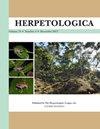Southeastern US Snake Species are Vulnerable to Egg Predation by Red Imported Fire Ants (Solenopsis invicta)
IF 1.1
3区 生物学
Q2 ZOOLOGY
引用次数: 0
Abstract
Abstract: Invasion and spread of Red Imported Fire Ants (RIFA; Solenopsis invicta) is cited as a possible cause for enigmatic reptile declines in the southeastern United States. Reptiles are negatively affected by RIFA through predation of eggs, hatchlings, and adults. We used short-term (12-h) field trials early in incubation to evaluate whether RIFA could successfully depredate intact eggs from six species of native terrestrial oviparous snakes: North American Racer (Coluber constrictor), Speckled Kingsnake (Lampropeltis holbrooki), Prairie Kingsnake (L. calligaster), Rough Greensnake (Opheodrys aestivus), Black Ratsnake (Pantherophis obsoletus) and Great Plains Ratsnake (P. emoryi). Then we used an artificial nest field experiment at the end of incubation to test whether RIFA predation differed between a species that has apparently declined in areas of its range where RIFA has invaded (L. holbrooki) and a species that has apparently not declined (C. constrictor). We measured pip–hatch and incubation time for each species in the laboratory to determine whether differences in time between pipping and hatching (pip–hatch time) could account for interspecific differences in RIFA predation on eggs. Overall, RIFA predation rates on snake eggs were high for all species (25–67% during early trials, 50–100% at end of incubation), although P. obsoletus was only depredated after hatching in the field. Coluber constrictor had significantly shorter pip–hatch times than other species, but probability of predation by RIFA did not differ for C. constrictor and L. holbrooki. Our study provides novel observations of RIFA predation and suggests that time spent in nest, eggshell characteristics, and nest microhabitat may be more important than pip–hatch time in mediating vulnerability of snake eggs to RIFA predation.美国东南部的蛇类物种很容易被红色进口火蚁(Solenopsis invicta)捕食卵
摘要:红进口火蚁(RIFA;Solenopsis invicta)的入侵和传播被认为是美国东南部神秘爬行动物数量减少的可能原因。爬行动物通过捕食卵、幼崽和成虫而受到RIFA的负面影响。我们在孵化早期使用了短期(12小时)的田间试验来评估RIFA是否能够成功地从六种本地陆生卵生蛇身上掠夺完整的卵:北美露脊蛇(Coluber constrictor)、斑点金蛇(Lampropeltis holbrooki)、草原金蛇(L.calligaster)、粗糙绿蛇(Opheodrys aestivus),黑Ratsnake(Pantrophis obsoletus)和大平原Ratsnake。然后,我们在孵化结束时使用人工巢场实验来测试在RIFA入侵的区域内明显减少的物种(L.holbrooki)和明显没有减少的物种之间(C.constrictor)对RIFA的捕食是否不同。我们在实验室中测量了每个物种的pip–孵化和孵化时间,以确定piping和孵化之间的时间差异(pip–孵育时间)是否可以解释RIFA捕食卵子的种间差异。总体而言,RIFA对所有物种的蛇卵捕食率都很高(早期试验期间为25-67%,孵化结束时为50-100%),尽管P.obsoletus只有在野外孵化后才会被捕食。与其他物种相比,蟒蛇的pip孵化时间明显更短,但蟒蛇和霍尔布鲁克的RIFA捕食概率没有差异。我们的研究提供了对RIFA捕食的新观察结果,并表明在介导蛇卵易受RIFA捕食方面,在巢穴中度过的时间、蛋壳特征和巢穴微栖息地可能比孵化时间更重要。
本文章由计算机程序翻译,如有差异,请以英文原文为准。
求助全文
约1分钟内获得全文
求助全文
来源期刊

Herpetologica
生物-动物学
CiteScore
4.60
自引率
0.00%
发文量
27
审稿时长
>12 weeks
期刊介绍:
Established in 1936, Herpetologica is a quarterly peer-reviewed journal serving herpetologists, biologists, ecologists, conservationists, researchers and the scientific community. The journal contains original research papers and essays about the biology of reptiles and amphibians, and covers many relevant topics including: behavior, conservation, ecology, genetics, morphology, physiology and taxonomy.
 求助内容:
求助内容: 应助结果提醒方式:
应助结果提醒方式:


